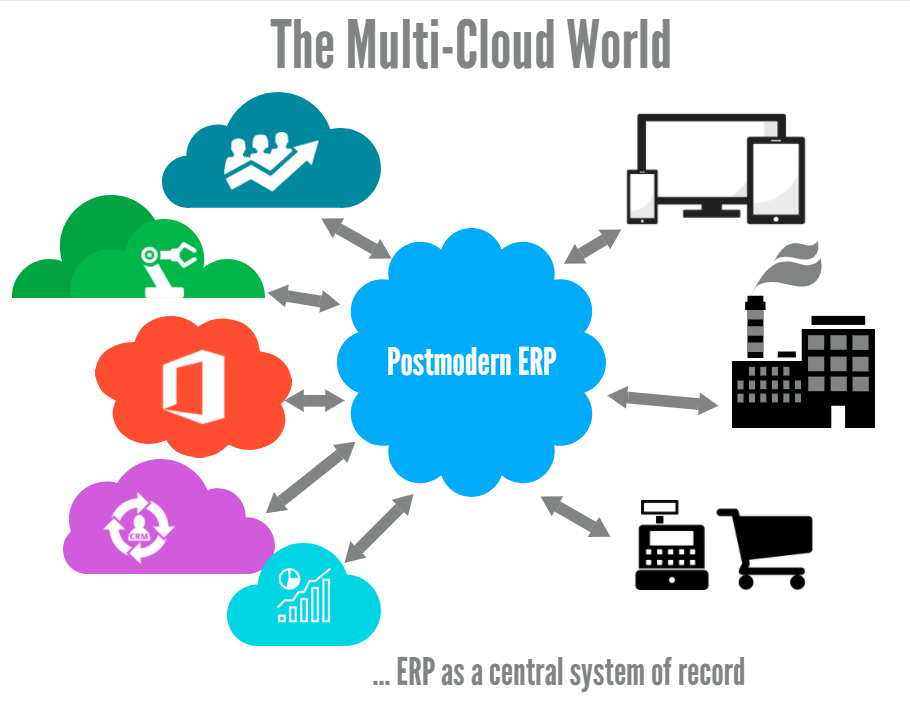Whether you are embracing it or not, you’re already living in the multi-cloud world at home and at work. I’d be willing to bet that you use Outlook, Gmail, Microsoft Office 365, ICloud and maybe even a cloud CRM like Salesforce. The biggest misconception about cloud applications is the belief that they’re hosted on “THE” cloud. “The” as in singular. There is no single cloud but rather many, many clouds.
“Isn’t the cloud just the internet? So, the singular internet means singular cloud, right?”
Yes but mostly no. It’s true that when you say you’re moving an application onto the cloud you’re really moving it onto the internet (singular). Instead of thinking of “The Cloud” as one big house with applications coexisting, think of cloud applications as separate houses in a “Cloud” world. Sometimes neighbors get along and create communities, but often they don’t speak to each other at all. Even though many different cloud applications can be hosted on the same internet, that doesn’t necessarily mean that they play well together. They are often actually very siloed. This can be infuriating since many businesses upgrade to cloud hosting with the intention of breaking down the data silos of the on-premises world, not simply moving them to the internet.
The first step in embracing the multi-cloud world is to think about your ERP Cloud strategy as the center point of your business’s multi-cloud hub. Your Cloud ERP should truly be the system of record for your business, as it is arguably (and we’re a little biased) the most critical for your business.

ERP vendors like Acumatica have begun to consider their user’s multi-cloud needs. This means actively creating bridges between cloud applications, breaking down silos and allowing businesses to fully embrace the multi-cloud world. Acumatica for example seamlessly integrates with Power BI, Outlook, Salesforce, Hubspot, DocuSign, Microsoft Office 365 and many other cloud applications that your business may need or already be using.
In the past, different ERP options were often evaluated solely by functionality. When choosing the right platform to serve as the focal point of your business’s multi-cloud hub, APIs (Application Programming Interface) should be added to the more traditional financial and/or logistical functionality considerations. Essentially, will this ERP solution integrate with all of the other applications your business is already using?
The best part about investing in vendors built for the multi-cloud world? You don’t have to worry about maintaining the old on-premises stack of hardware, databases, and applications. The vendors run the stack and you get to focus on running your own business. According to Acumatica’s Ali Jani, “Selecting vendors who are built for a multi-cloud world allows a company of 200 people to do what you used to need 1,000 people to do.” You’re able to achieve this level of efficiency and success because of the mobility and interoperability of the multi-cloud world.
Cloud technology is inherently mobile, especially with the popularization of smartphones and tablets, allowing you to access the cloud from anywhere. With this type of technology, you have the ability to conduct business anytime, anywhere. Many cloud applications offer mobile apps to enhance the user experience due to restrictions like screen real-estate. The key is to be able to access software and apps based in various clouds that communicate with each other easily no matter where you are or what device you’re using.
Before the multi-cloud, integrating business applications was the bane of many an IT department’s existences. Often, this led to data silos when applications wouldn’t cooperate and play nice with each other. In the early days of the cloud computing era, a set of open standards were defined, dictating standards for the way pieces work for an individual application and how an application talks to another application. The current model of these standards is referred to as REST (Representational State Transfer). This standard for how cloud applications interact with each other has came to be known as “cloud interoperability” and is what deters businesses from ending up in a siloed cloud environment.
Companies who embrace the multi-cloud world are set up for success. They have chosen to center their business around an ERP solution that is mobile, scalable, adaptable and easily integrated into other cloud environments. Their IT department doesn’t have to worry about maintaining a stack of hardware and integrating stubborn software.
If you’re interested in setting your business up for success and fully embracing the multi-cloud world, contact one of our representatives today!
Solutions by Industry
What's New
Navigating Intelligent Digital Transformation in 2026
Read MoreSubmitted by Stephanie Dean on Mon, 01/05/26 - 13:01
Fiscal Fitness: Preparing Your Business for Year-End Excellence with ACC
Read MoreSubmitted by Stephanie Dean on Mon, 12/29/25 - 11:50
Farewell to 2025: A Smarter Year-End Starts with Acumatica
Read MoreSubmitted by Stephanie Dean on Wed, 12/24/25 - 10:07